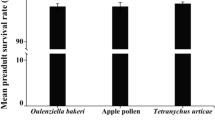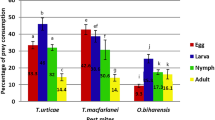Abstract
Amblyseius orientalis (Ehara) (Acari: Phytoseiidae) is an effective predatory mite for spider mite control on fruit trees in China. In recent decades, it has been produced massively at a commercial natural enemy producer, feeding on the storage mite Carpoglyphus lactis (L.). In the predator production process, the ratio of predatory mites to their prey was found to be critical for the population increase of A. orientalis in large-scale rearings. In this study, we investigated the predatory capacity of A. orientalis on various developmental stages of the prey C. lactis, and the effect of prey numbers on predator reproduction. The maximum predation rate of A. orientalis adults on C. lactis adults was 2.21 per day at the lowest density of five prey adults, and on C. lactis eggs it was 45.07 at the highest density of 60 prey eggs. The preference index Ci of A. orientalis on C. lactis eggs and adults was 0.4312 and − 0.9249, respectively, suggesting that A. orientalis preferred eggs to adults. Amblyseius orientalis could reproduce when it preyed on either eggs or deutonymphs of C. lactis. However, the fecundity of the predatory mites is not always proportional to the provided prey number. Higher density of prey deutonymphs resulted in lower fecundity, whereas more prey eggs resulted in higher fecundity of A. orientalis. Therefore, our study indicated that the choice of suitable density and developmental stage of prey can significantly improve A. orientalis production on a large scale.





Similar content being viewed by others
References
Furuichi H, Oku K, Yano S, Takafuji A, Osakabe M (2005) Why does the predatory mite Neoseiulus womersleyi Schicha (Acari: Phytoseiidae) prefer spider mite eggs to adults? Appl Entomol Zoolog 40:675–678. https://doi.org/10.1303/aez.2005.675
Ganjisaffar F, Perring TM (2015) Prey stage preference and functional response of the predatory mite Galendromus flumenis to Oligonychus pratensis. Biol Control 82:40–45. https://doi.org/10.1016/j.biocontrol.2014.12.004
Gotoh T, Tsuchiya A, Kitashima Y (2006) Influence of prey on developmental performance, reproduction and prey consumption of Neoseiulus californicus (Acari: Phytoseiidae). Exp Appl Acarol 40(3–4):189–204. https://doi.org/10.1007/s10493-006-9032-3
Harvey JA, Cloutier J, Visser B, Ellers J, Wäckers FL, Gols R (2012) The effect of different dietary sugars and honey on longevity and fecundity in two hyperparasitoid wasps. J Insect Physiol 58(6):816–823. https://doi.org/10.1016/j.jinsphys.2012.03.002
Huang H, Xu X, Lv J, Li G, Wang E, Gao Y (2013) Impact of proteins and saccharides on mass production of Tyrophagus putrescentiae (Acari: Acaridae) and its predator Neoseiulus barkeri (Acari: Phytoseiidae). Biocontrol Sci Technol 23(11):1231–1244. https://doi.org/10.1080/09583157.2013.822849
Ivlev VS, Scott D, Winberg GG, Fry FEJ, Ricker WR (1962) Experimental Ecology of the feeding of fishes. Chesapeake Sci 3(1):56–58. https://doi.org/10.2307/1350423
Knapp M, Houten YM, Baal EV, Groot TV (2018) Use of predatory mites in commercial biocontrol: current status and future prospects. Acarologia 58:72–82. https://doi.org/10.24349/ACAROLOGIA/20184275
Liao YM, Zhu ZM (1985) Study on the feeding habits of Amblyseius orientalis. Jiangxi Plant Prot 3:17–18
Midthassel A, Leather S, Wright DJ, Baxter IH, Farman DI, Cork A (2016) An astigmatid defense volatile against a phytoseiid mite. Entomol Exp Appl 158:97–107. https://doi.org/10.1111/eea.12382
Moghadasi M, Saboori A, Allahyari H, Golpayegani A (2013) Prey stages preference of different stages of Typhlodromus bagdasarjani (Acari: Phytoseiidae) to Tetranychus urticae (Acari: Tetranychidae) on rose. Persian J Acarol 2:531–538. https://doi.org/10.22073/PJA.V2I3.10047
Naeem T, Bajwa BE, Mazhar MS, Jamil N, Khan SB (2017) Prey stage preference and predatory potential of Typhlodromus divergentis (Acari: Phytoseiidae) against two spotted spider mites, Tetranychus urticae (Acari: Tetranychidae). J Agric Res 55:661–669
Nguyen DT, Vangansbeke D, Lü X et al (2013) Development and reproduction of the predatory mite Amblyseius swirskii on artficial diets. Biol Control 58:369–377. https://doi.org/10.1007/s10526-012-9502-y
Osman MA, Abou-Elella GM, Rasmy AH (2016) Life table parameters of the predatory mite, Cydnoseius negevi (Swirski & amitai) affected by prey density of Tetranychus urticae koch (acari: Phytoseiidae, tetranychidae). Egypt J Biol Pest Control 26(4):827–832
Ramachandran D, Lindo Z, Meehan ML (2021) Feeding rate and efficiency in an apex soil predator exposed to short-term temperature changes. Basic Appl Ecol 50(Suppl):87–96. https://doi.org/10.1016/j.baae.2020.11.006
Rasmy AH, Abou-Elella GM (2002) Effect of prey density on functional and numerical responses of the predatory mite typhlodromus negevi (acari: phytoseiidae). Springer Neth. https://doi.org/10.1007/978-94-017-0611-7_31
Saemi S, Rahmani H, Kavousi A, Chi H (2017) Group-rearing did not affect the life table and predation rate of Phytoseiulus persimilis (Acari: Phytoseiidae) fed on Tetranychus urticae. Syst Appl Acarol 22(10):1698. https://doi.org/10.11158/saa.22.10.11
Sheng FJ, Wang ED, Xu XN, Wang BM (2014) Life table of experimental population of Amblyseius orientalis feeding on Carpoglyphus lactis. Chin J Biol Control 30(02):194–198. https://doi.org/10.16409/j.cnki.2095-039x.2014.02.004
Song Y, Ha T, Chung D, Heong KL (1995) The predatory behavior of green mirid bug, Cyrtorhinus lividipennis Reuter, on brown planthopper eggs in different temperature conditions. Korean J Appl Entomol 34(3):234–242
Szlendak E, Lewandowski M (2009) Development and reproductive capacity of the predatory mite parasitus consanguineus (Acari: Parasitidae) reared on the larval stages of Megaselia halterata and Lycoriella ingenua. Exp Appl Acarol 47(4):285–292. https://doi.org/10.1007/s10493-008-9218-y
Wang BM, Wang ZQ, Wu ZY, Wang XW, Fan QH (2008) The occurrence and control of Carpoglyphus lactis (Linnaeus) (Acari:Carpoglyphidae). J Biosaf 17(02):156–160
Wen L, Jiao X, Liu F, Zhang S, Li D (2020) High-lipid prey reduce juvenile survivorship and delay egg laying in a small linyphiid spider Hylyphantes graminicola. J Exp Biol. https://doi.org/10.1242/jeb.237255
Werling BP, Lowenstein DM, Straub CS, Claudio G (2013) Multi–predator effects produced by functionally distinct species vary with prey density. J Insect Sci 1:30. https://doi.org/10.1673/031.012.3001
Williams L 3rd, Roane TM (2007) Nutritional ecology of a parasitic wasp: food source affects gustatory response, metabolic utilization, and survivorship. J Insect Physiol 53(12):1262–1275. https://doi.org/10.1016/j.jinsphys.2007.06.017
Woods MJ, Conlong DE, Ngomane N, Gillespie DY, Hoffman LC, Pieterse E (2020) The development of an improved artificial diet for the mass rearing of Eldana saccharina Walker (Lepidoptera: Pyralidae). J Sci Food Agric 100(13):4678–4687. https://doi.org/10.1002/jsfa.10466
Wu ZY, Zhang XH, Jia L, Fan QH (2009) Effects of five preys on growth and reproduction of lasioseius sp. J Fujian Agric Forestry Univ (Natural Sci Edition) 38:581–584
Yan H, Zhang B, Li ZP (2022) Phenotypic plasticity of predatory mite Amblyseius orientalis in response to diet switch. Syst Appl Acarol 27(6):1098–1108. https://doi.org/10.11158/saa.27.6.9
Yang JY, Sheng FJ, Song ZW, Lv JL, Xu XN, Li DS, Wang ED (2018) Functional responses of Amblyseius orientalis and A. tsugawai to eggs and 1st instar of Bemisia tabaci. Chin J Biol Control 34(02):214–219. https://doi.org/10.16409/j.cnki.2095-039x.2018.02.006
Zhang SY (1990) Research on the biology and foods of Amblyseius orientalis. Nat Enemies Insects 12(1):21–24
Zhang K, Zhang ZQ (2021) The dried fruit mite Carpoglyphus lactis (Acari: Carpoglyphidae) is a suitable alternative prey for Amblyseius herbicolus (Acari: Phytoseiidae). Syst Appl Acarol 26(11):2167–2217. https://doi.org/10.11158/saa.26.11.15
Zhang SY, Cao XW, Han ZQ, Wu WN (1992) Research on natural control of two spider mites by Amblyseius orientalis (Acari: Phytoseiidae) in apple orchards. Nat Enemies Insects 14(1):21–24
Zhang XX, Lv JL, Hu Y, Wang BM, Chen X, Xu XN, Wang ED (2015) Prey preference and life table of Amblyseius orientalis on Bemisia tabaci and Tetranychus cinnabarinus. PLoS ONE 10(10):e0138820. https://doi.org/10.1371/journal.pone.0138820
Zheng FQ, Zhang XH, Mo TL, Zheng JQ, Wu JB (2008) Ecological niches and guilds of main insect pests and their natural enemies on apple trees. Acta Ecol Sin 28:4830–4840
Zhou JZ, Chen CM (1987) Quantitative measurement of selectivity of predator for prey. Acta Ecol Sin 7(1):50–56
Acknowledgements
This work was supported by National Key R&D Program of China (2022YFD1401200) and Beijing Agriculture Innovation Consortium (BAIC01-2022).
Author information
Authors and Affiliations
Contributions
JW and YL: Investigation, formal analysis, Writing—original draft preparation, reviewing and editing. FS: Investigation and formal analysis. BZ: Conceptualization, Fformal analysis, supervision, writing—original draft preparation, reviewing and editing. EW and XX: Validation, supervision and editing.
Corresponding authors
Ethics declarations
Competing interests
The authors declare no competing interests.
Additional information
Publisher’s Note
Springer nature remains neutral with regard to jurisdictional claims in published maps and institutional affiliations.
Rights and permissions
Springer Nature or its licensor (e.g. a society or other partner) holds exclusive rights to this article under a publishing agreement with the author(s) or other rightsholder(s); author self-archiving of the accepted manuscript version of this article is solely governed by the terms of such publishing agreement and applicable law.
About this article
Cite this article
Wei, J., Liu, Y., Sheng, F. et al. Predatory mite Amblyseius orientalis prefers egg stage and low density of Carpoglyphus lactis prey. Exp Appl Acarol 90, 267–276 (2023). https://doi.org/10.1007/s10493-023-00805-3
Received:
Accepted:
Published:
Issue Date:
DOI: https://doi.org/10.1007/s10493-023-00805-3




